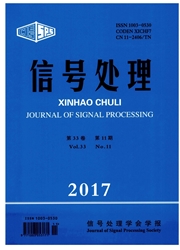

 中文摘要:
中文摘要:
多重信号分类(multiple signal classification:MUSIC)方法通过计算搜索导向矢量与噪声或信号子空间的距离来估计波达方向,对采样协方差矩阵的依赖性较大。在小快拍或存在强弱临近信号条件下,采样协方差矩阵的估计值与真实值通常存在较大差异,导致估计的噪声或信号子空间发生畸变,严重恶化了MUSIC方法的波达角估计性能。针对该问题,本文提出采用加权伪噪声子空间投影的改进方法(称为wpnMUSIC)。该方法在修正数据相关矩阵的基础上估计与搜索导向矢量对应的伪噪声子空间并利用其在伪噪声子空间的投影值对MUSIC空间谱进行加权处理,在保持子空间处理方法高分辨能力的同时改善了对小快拍和强弱信号的稳健性。理论分析和仿真实验表明本文方法对强弱临近目标的分辨能力优于MUSIC方法。
 英文摘要:
英文摘要:
The direction-of-arrival(DOA) can be estimated as measured the distance between each search steering vector and the noise subspace or signal subspace with MUSIC algorithm.Therefore,the subspace deviation which associated with the correlation matrix will deteriorate the performance of MUSIC algorithm.To alleviate this decreasing in DOA estimation with secondary data deficient scenario and/or strong and weak signal coexistence,a new method based on pseudo-noise subspace projection is presented.The approach is performed in two stages.First,we employ a modified correlation matrix at each search steering vector to calculate the pseudonoise subspace,then,the spatial spectrum can be obtained as weighted the MUSIC spectrum with the projection value of the search steering vector on the corresponding pseudo-noise subspace.The high-resolution of subspace processing is remained and the robustness against small sample support and in the presence of strong signal and weak signal is improved.Theoretical analysis and numerical simulation indicate that its performance is better than that of MUSIC.
 同期刊论文项目
同期刊论文项目
 同项目期刊论文
同项目期刊论文
 A Modified Fast Approximated Power Iteration Subspace Tracking Method for Space-Time Adaptive Proces
A Modified Fast Approximated Power Iteration Subspace Tracking Method for Space-Time Adaptive Proces Airborne GMTI experiment based on multi-channel synthetic aperture radar using space time adaptive p
Airborne GMTI experiment based on multi-channel synthetic aperture radar using space time adaptive p Performance improvement for monostatic clutter mitigation using space-time-range three-dimensional a
Performance improvement for monostatic clutter mitigation using space-time-range three-dimensional a 期刊信息
期刊信息
